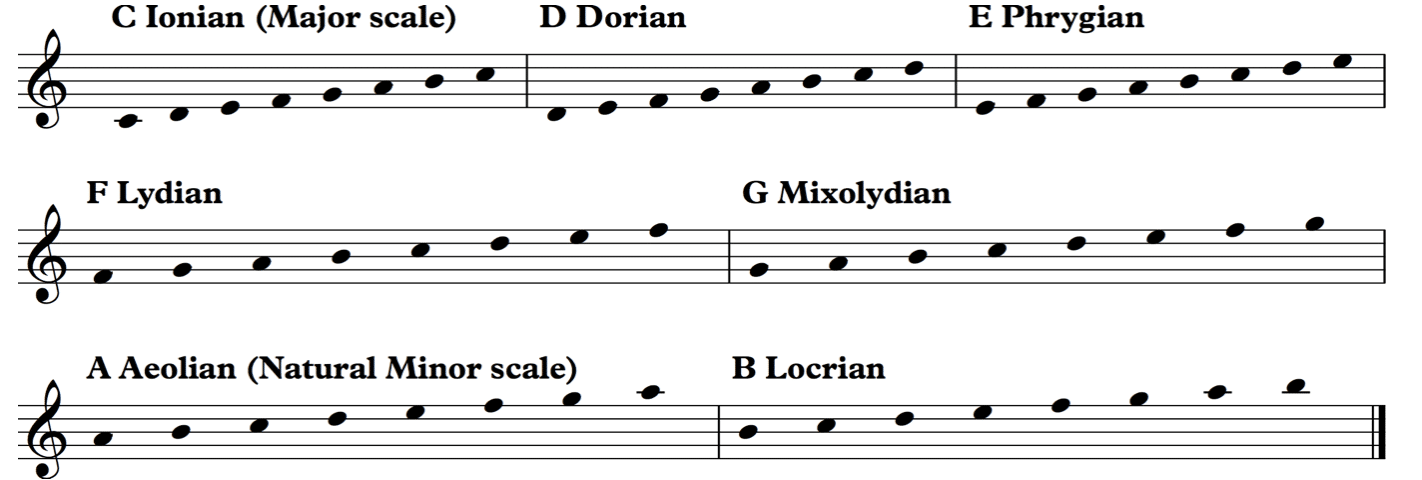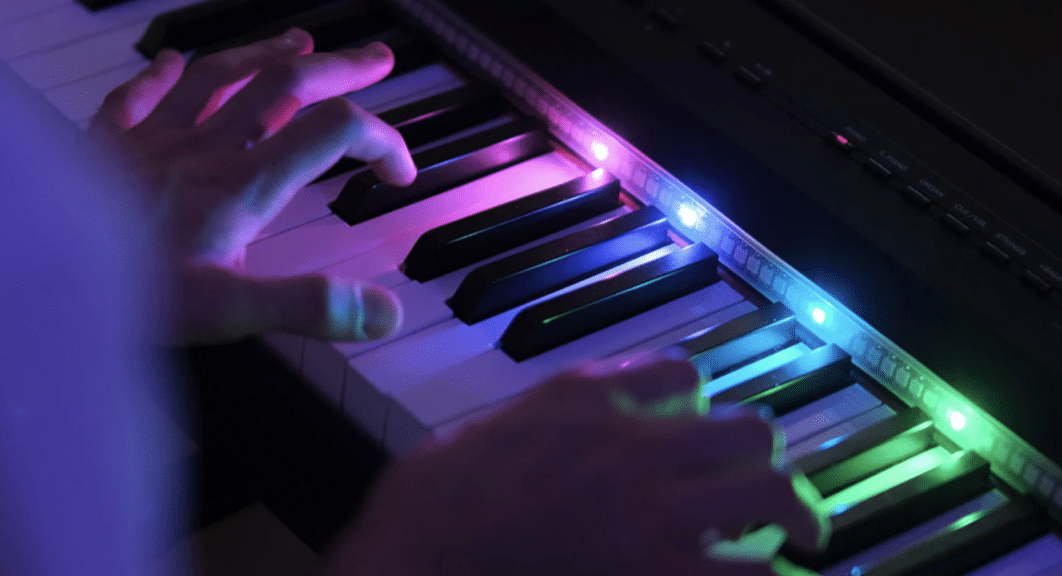The Locrian mode is one of the most intriguing and unique musical modes in western music.
It consists of a sequence of half steps and whole steps that create a distinctive, dissonant sound, which we’ll break down in detail.
This musical mode creates perfect tension and release 一 making it a valuable tool in various musical genres, such as folk music, jazz, metal, etc.
It also provides a unique sound palette and challenges traditional harmonic structures for some fresh creative possibilities.
So, as a music producer, it’s important to know all about the Locrian mode (and other modes) in order to enhance your theory skills and create more dynamic music.
In this article, you’ll learn about:
- What is the Locrian mode ✓
- Scale structure & note sequence ✓
- Comparing Locrian to the major scale & minor scale ✓
- The importance of the flattened fifth scale degree ✓
- Creating dissonance and tension ✓
- Using the Locrian mode ✓
- Advanced tips ✓
- Integrating Locrian with other modes ✓
- Creating unique chord progressions ✓
- Understanding scale degrees ✓
- Relationship with other musical modes ✓
- Much more ✓
After reading this article, you’ll know everything about the Locrian mode and how to incorporate it into your own music.
This way, you’ll be able to add a distinctive edge and depth to your tracks, creating music like a true professional.
So, let’s dive in…
Table of Contents
What is the Locrian Mode?

The Locrian mode is one of the seven musical modes, known for its distinctive and dissonant sound.
It is the seventh mode of the diatonic scale, starting from the seventh scale degree of the major scale.
Unlike the major scale and minor scale variations, the Locrian mode contains a flattened fifth scale degree, which creates its unique, unstable sound.
In music theory, the Locrian mode is considered the most unstable of all the modes due to its diminished fifth (which is pretty interesting).
The scale sequence of the Locrian mode is:
- Whole step
- Half step
- Whole step
- Half step
- Whole step
- Whole step
- Whole step
This sequence includes half-steps that contribute to its tense sound 一 differing significantly from the major and minor scales.
Don’t worry, we’ll break everything down throughout the article because really understanding the Locrian mode can really enhance your music.
It will give it that distinctive, edgy character that people are super drawn to.
Scale Structure: Breaking it Down
Let’s break down this interesting musical mode further by discussing its unique note sequence, comparing it to major scales/minor scales, and using it to create extra tension and dissonance.
-
Note Sequence

The Locrian mode follows a specific note sequence that sets it apart from other scales.
Starting from the root note, the sequence is: half step, whole step, whole step, half step, whole step, whole step, whole step.
This pattern of whole and half steps gives the Locrian its characteristic sound (remember, half steps equal semi-tones and whole steps equal whole tones).
The signature half-steps create a sense of tension and instability, which you can use creatively in your own tracks.
For example, in the B Locrian scale, the notes are:
- B
- C
- D
- E
- F
- G
- A
The intervals between these notes are essential to the mode’s unique sound and, unlike the natural minor scale, the Locrian mode’s flattened fifth scale degree plays a key role.
The relationship between the notes through these half-steps and whole steps provides the distinctive dissonance that defines the Locrian mode.
So, the real key to understanding it is memorizing this pattern.
Comparing Locrian to Major Scales and Minor Scales
When comparing the Locrian mode to major scales and minor scales, there are several key differences that you’ll need to know.
The Major Scale

The major scale, also known as the Ionian mode, is characterized by its bright, uplifting, and stable sound.
It follows a pattern of whole steps and half steps 一 whole step, whole step, half step, whole step, whole step, whole step, half step.
This structure of whole steps and half steps provides a sense of resolution and completeness that people really connect to.
Remember, the Locrian sequence includes one half step at the second interval and a flattened fifth which causes dissonance and instability.
The Minor Scale

The minor scale, or Aeolian mode, has a darker/sadder tone than the major scale 一 whole step, half step, whole step, whole step, half step, whole step, whole step.
The Locrian mode differs significantly by having a flattened fifth scale degree, resulting in a diminished triad rather than a minor or major triad.
For instance, the B Locrian scale includes the notes B-C-D-E-F-G-A-B whereas the B natural minor scale (Aeolian) includes the notes B, C#, D, E, F#, G, and A.
This flattened fifth is everything when it comes to creating the Locrian mode’s unique sound, so it’s perfect for genres that thrive on tension and dissonance.
It’s especially popular in avant-garde classical music and certain metal subgenres.
Using the Locrian Mode
Now that you have a solid understanding of the Locrian mode, let’s get into some advanced tips that can help you create interesting songs and get further into popular music theory techniques.
-
Advanced Tips for Using Locrian Mode

Incorporating the Locrian into your music can add depth and complexity.
One advanced tip is to use the Locrian mode in certain sections of your track to create extra moments of tension and intrigue.
This will also prevent its dissonance from becoming overwhelming.
Transitioning from Locrian to a more stable mode (such as the Ionian or Dorian) can provide a satisfying resolution and contrast.
Another tip is to use the Locrian mode to create unique melodies and basslines…
By focusing on the flattened fifth and other characteristic intervals, you can create lines that are both captivating and memorable.
NOTE: Experiment with different rhythms, note durations, and phrasings to fully explore the Locrian mode’s possibilities and makes your tracks pop.
-
Integrating Locrian with Other Modes

Combining the Locrian mode with other modes can produce exciting musical results.
For example, transitioning from the Locrian mode to the Ionian mode (major scale) can bring some much-needed contrast/conflict.
In fact, this technique is often used in film scores to shift the mood dramatically.
NOTE: Moving from Locrian to the Mixolydian mode can introduce a bluesy feel.
Another effective combination is using the Locrian mode alongside the Phrygian mode…
Both modes share a dark, exotic sound, but the Locrian’s flattened fifth adds an extra layer of tension that the Phrygian mode doesn’t contain.
This interplay between modes can help you stumble upon some pretty interesting sounds, and experimenting will only help enhance your skills even more.
-
Pro Tip: Creating Unique Chord Progressions

The Locrian mode is ideal for creating a unique chord progression, so try starting with a diminished triad built on the root note.
For example, in the B Locrian mode, this would be a B diminished chord.
Follow this with chords that resolve the tension 一 like moving to a major chord or minor chord from a different mode.
This technique can create progressions that are both unexpected and engaging.
Understanding Scale Degrees in Locrian

Scale degrees are the positions of each note within a scale, starting from the root note.
In the Locrian mode, each scale degree (like the third scale degree) plays a specific role, with the most notable being the flattened fifth, of course.
The seventh scale degree also plays a significant role 一 adding to the mode’s tension.
By emphasizing these degrees, you can highlight the Locrian mode’s unique characteristics.
For instance, in the B Locrian mode, the scale degrees are:
- B (root)
- C (second)
- D (third)
- E (fourth)
- F (flattened fifth)
- G (sixth)
- A (seventh)
Each scale degree contributes to the overall feel of the mode.
Understanding how these degrees interact can help you use the Locrian like the professionals songwriters and musicians do.
Experiment with emphasizing different degrees to create interesting effects.
Locrian Mode in Music Theory: Relationship with Other Musical Modes (Summing it Up)

The Locrian mode’s relationship with other musical modes is essential for understanding its place in music theory.
As the seventh mode of the diatonic scale, it follows the Mixolydian mode and precedes the Ionian mode.
This positioning simply means it starts on the seventh scale degree of the major scale… For example, in the C major scale, the Locrian mode starts on B.
Therefore, it’s the B Locrian scale (simple, right?).
The way to truly see its distinctiveness is by comparing it to different modes like the Dorian and Phrygian.
For instance, while Dorian and Phrygian are minor modes, the Locrian’s flattened fifth sets it apart.
Minor modes don’t include that signature flattened fifth, which is what it’s all about.
This interval creates a diminished triad, unlike the minor triads found in the Dorian and Phrygian modes.
Side note, if you want to learn all about triads, we’ve got you covered.
The unique dissonance of the Locrian mode can be used to add tension and intrigue to your tracks, as we talked about earlier.
Understanding the Locrian mode in relation to other modes helps in creating smooth transitions and complex harmonic progressions.
For instance, transitioning from the Locrian mode to the Mixolydian mode can shift the mood from tense to more relaxed.
Using these different relationships can enhance the emotional impact of your music and help you up your skills even more.
Exploring how the Locrian mode interacts with other modes, such as the Aeolian or Ionian, can provide a richer palette of sounds and creative possibilities.
Final Thoughts
The Locrian mode is a powerful tool in the arsenal of any music producer.
As we talked about, it’s one of the most unique and dissonant modes, known for its flattened fifth scale degree and the tension it creates.
It can help you add depth and complexity to your tracks 一 pushing the boundaries of traditional harmonic structures (as you should).
To further enhance your understanding and application of the Locrian mode and other scales, make sure to check out the Free Advanced Scales MIDI Essentials.
This collection contains 24 unique, impressive MIDI scales, chord progressions, and melodies that you can plug and play right away.
Everything is 100% royalty-free, so it’s a truly invaluable resource for learning more about music theory and experimenting with different modes in your own music.
Remember to use the Locrian mode creatively in your own tracks, and explore the endless possibilities it offers to make your music stand out.
You never know what you can stumble across.
Until next time…







Leave a Reply
You must belogged in to post a comment.